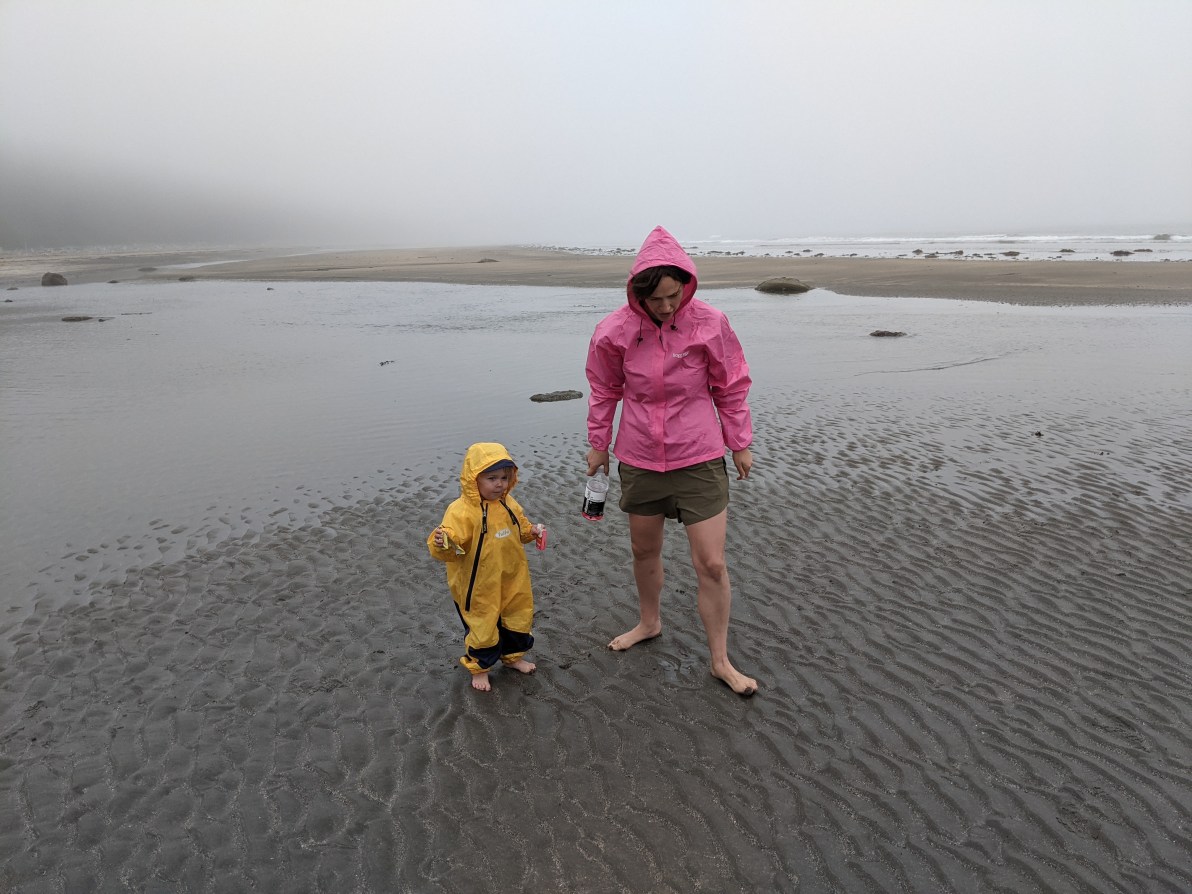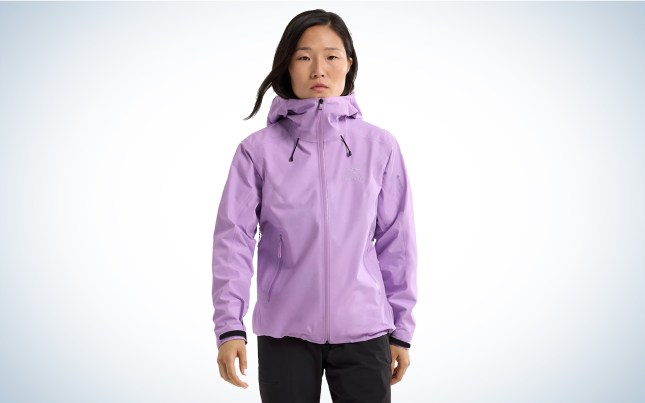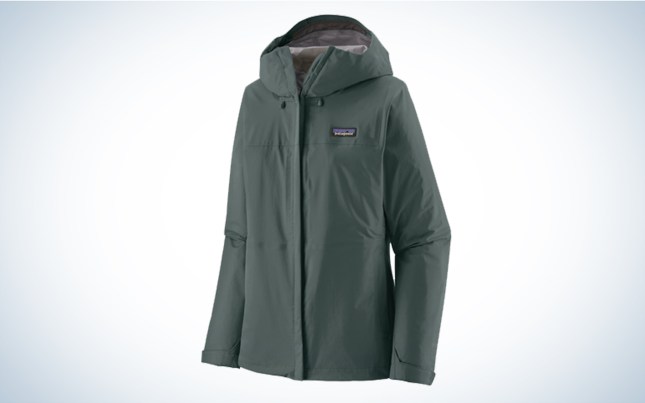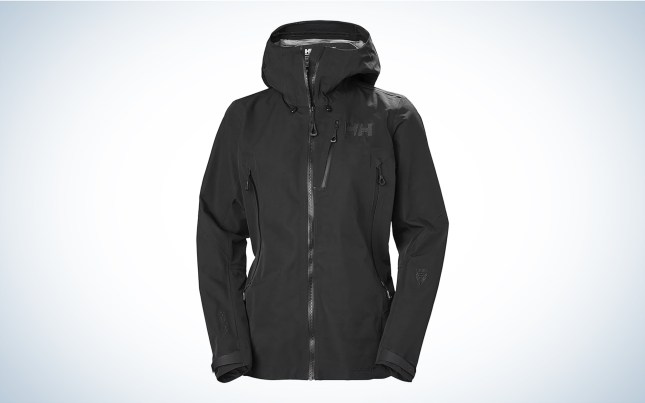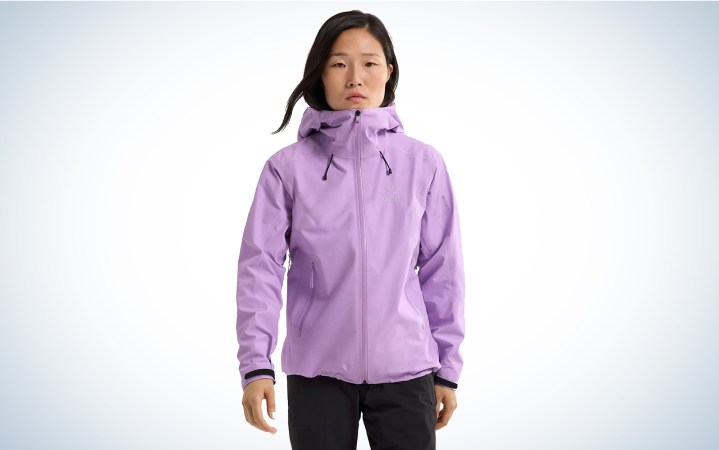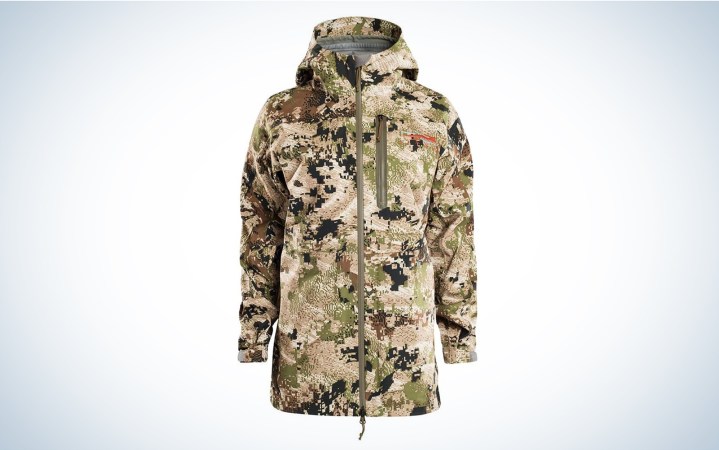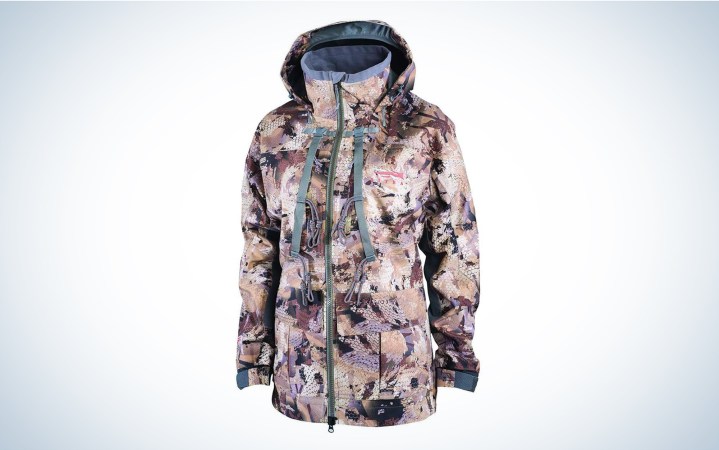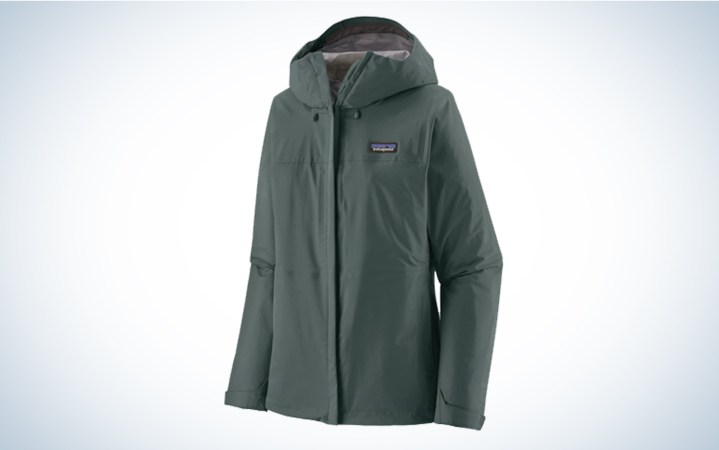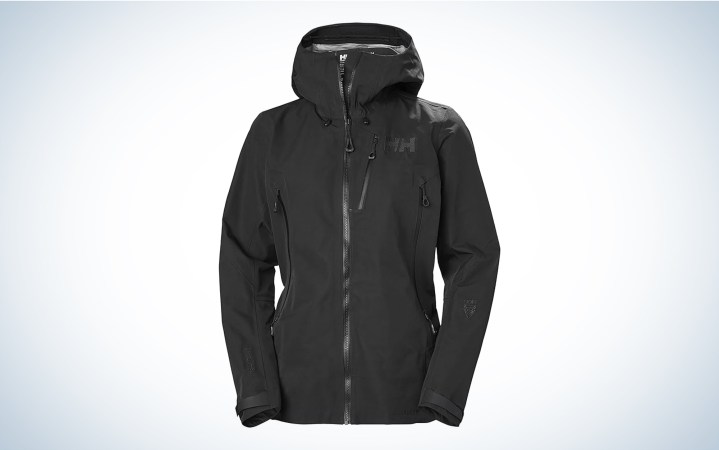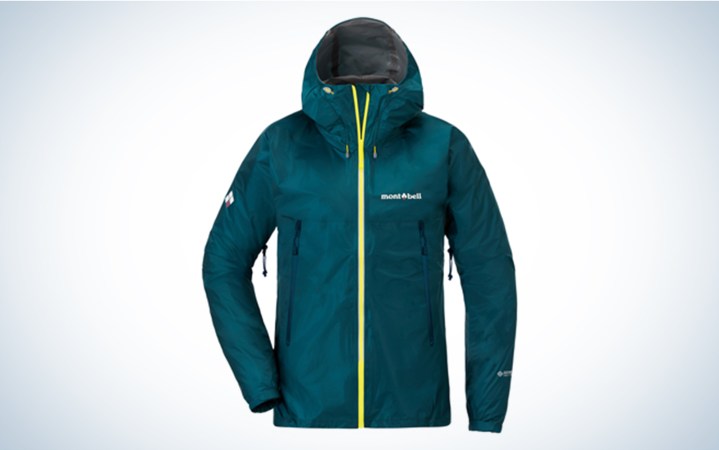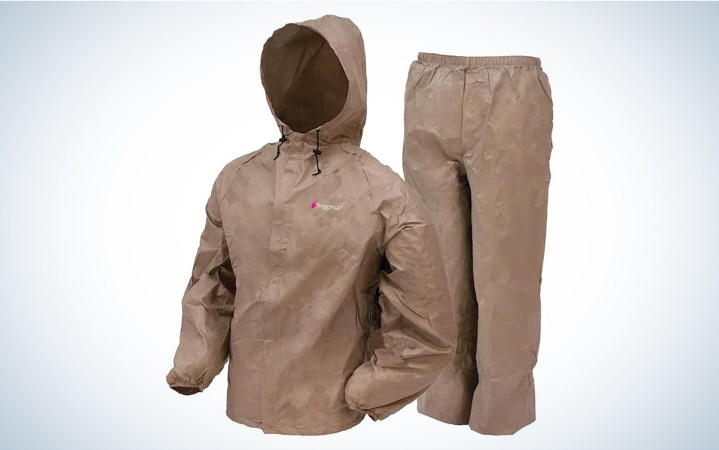We may earn revenue from the products available on this page and participate in affiliate programs. Learn More ›
The rain jackets that work best for women are not the same as those that work the best for men. Because women typically sweat less, their rain jackets often skip the pit zips (a major waterproofing fail point) and so-called breathable Gore-Tex. For women, absolute waterproofing and protection is paramount, as is performing at the same high level that we’ve come to expect from the comparable men’s lineup. Here are our picks for the best rain jackets for women, based on years of in-field testing and experience.
- Best Overall: Arc’teryx Beta LT
- Best for Deer and Turkey Hunting: Sitka Cloudburst
- Best for Waterfowl Hunting: Sitka Hudson
- Best for All-Season: Patagonia Torrentshell
- Best for Extreme Conditions: Helly Hansen Odin 9 Worlds Infinity Shell Jacket
- Best Lightweight: Montbell Versalite
- Best Budget: Frogg Toggs UltraLite Suit
How We Tested the Best Rain Jackets for Women
Outdoor Life editors, staff writers, and contributors regularly test rain jackets for women (as well as waterproof hiking shoes, hunting jackets, and underwear) out in the field. We’ve taken these jackets backpacking, deer hunting, thru-hiking, waterfowl hunting, and subjected them to everything from torrential rainfall in Utah to never-ending mist in the Pacific Northwest. I’m confident that no matter what outdoor activity you’re outfitting for, there is an option on this list that will match your needs.
Best Rain Jackets for Women: Tested & Reviewed
Best Overall: Arc’teryx Beta LT
Key Features
- Sizes: XXS to XXL
- Weight: 8.5 ounces
- Waterproofing: 3L Gore-Tex
- Pockets: Two zip pockets at the waist
Pros
- Extremely waterproof and wind resistant
- Lightweight for the protection it provides
- Durable
Cons
- Expensive
- No pit zips
The Arc’teryx Beta LT was the most waterproof, wind-resistant jacket in my test of the best backpacking rain jackets, and incorporated a number of features that guaranteed that not one inch of your insulation layer or baselayer will get wet. The generous hood (even the puffiest of puffers will fit under this one) has cinch cords both at the back and by the chin so that you can get a secure fit, while the cuffs have velcro tabs that you can tighten when the wind picks up or loosen again when you need to cool off a bit. It also incorporates a noticeable drop-tail hem, which helps to ensure you have full coverage when paired with rain pants.
The Arc’teryx Beta LT does not include pit zips, and the material it is made out of is not breathable. While most women sweat less than men, making this a non-issue, if you do run hot consider another pick on this list. This is also a very expensive rain jacket, hundreds of dollars more than what you’d typically pay for one of the best hiking jackets.
Best for Deer and Turkey Hunting: Sitka Cloudburst
Key Features
- Sizes: XS to XL
- Weight: 21.6 ounces
- Waterproofing: 3L Gore-Tex
- Pockets: Two zip pockets at hips, one zip pocket at chest
Pros
- Performs well in a wide variety of conditions
- Great adjustment points
Cons
- Doesn’t excel at any one thing
- Not as quiet as others on the market
The Sitka Cloudburst is my go-to hunting rain jacket. It gets the most mileage during my turkey season, when I’m often hunting in steady rain or I get caught in a thunderstorm and have to fish it out of my vest. The Cloudburst doesn’t necessarily excel at any one thing, but it’s capable by almost every measure. It’s the goldilocks of my hunting rain jackets. It’s not so lightweight that water soaks through after a heavy downpour, nor so heavy or bulky that I inevitably leave it behind so I don’t have to carry it. Instead, it’s just right.
The fabric isn’t the quietest, but it’s not warm-up-pants swishy either, and the camo pattern (Gore Optifade Subalpine) matches the intense spring green-up where I hunt in the Midwest. The fit is roomy enough that you can layer it over a down puffy or heavier mid-layer during those cold, humid mornings. Best of all, the jacket has adjustable cuffs, hems, and a hood that fits neatly over a baseball cap. The cinch on the back of the hood let’s you draw the hood back from your peripheral vision to reduce the horse-blinder effect of many hunting hoods. This lets me detect movement without turning my head, and it also keeps the hood from obstructing your view once you tug a facemask on in a hurry. —Natalie Krebs
Best for Waterfowl Hunting: Sitka Hudson
Key Features
- Sizes: XS to XXL
- Weight: 42 ounces
- Waterproofing: Three-layer Gore-Tex stretch technology
- Pockets: Two open pockets at the chest, two shell pockets at the waist, and two call pockets at the chest
Pros
- Features Primaloft insulation for extra warmth in cold conditions
- Seals up against water and wind
- Plenty of pockets for the odds and ends waterfowl hunters need
Cons
- Runs slightly small (consider sizing up if you are in between sizes)
- Could use another pair of pockets for your hands at the waist
In her review of the Sitka Hudson jacket, OL assistant editor Ashley Thess noted that this jacket was intentionally designed for waterfowl hunters. While it was very effective at blocking the cold of the water and the outside air while she was breaking up ice in front of the boat, the bulk wasn’t so much that she missed out on any of the flexibility needed for waterfowl hunting (including hauling yourself back into the boat).
The bulk it does have includes a hefty amount of synthetic Primaloft insulation inside the jacket, which, in addition to her other layers, helped Ashley stay warm in the predawn hours. In addition to the Gore-Tex 3L waterproofing, the cuffs of this jacket have a gasket seal on them, which prevents water from creeping up your sleeve. The Sitka Hudson comes in Gore Optifade concealment waterfowl marsh camo, and has a bevy of pockets that waterfowl hunters will appreciate: a pair for their hands, a pair for their ammo, and a pair for their calls.
Read the Review: Sitka Hudson Jacket: A Hardcore Shell for Waterfowl Hunters
Ashley also noted that the medium, the size she typically wears in rain jackets, compressed her other layers more than she was expecting, inhibiting their ability to keep her warm. If you run cold and like to layer up, then consider purchasing a larger size jacket than you normally would.
Best All-Season: Patagonia Torrentshell
Key Features
- Sizes: XS to XXL
- Weight: 12.4 ounces
- Waterproofing: H2No Performance Standard three-layer
- Pockets: Two pockets at hips
Pros
- Has pit zips to vent in warmer weather
- Microfleece-lined neck for extra comfort
Cons
- Heavier than other available options
OL staff writer Katie Hill’s go-to rain jacket is the Patagonia Torrentshell, which she appreciates for its functionality in a wide range of conditions. She uses it throughout the year, from winter sports to backpacking in Zion in July, but is most impressed by the flexibility of the material. That allows her to move naturally, making this her go-to choice for trail running in addition to hiking, fishing, and working outside.
She can get away with that in a non-breathable rain jacket even while running because the Patagonia Torrentshell incorporates zips underneath the armpits that allow her to dump heat when she’s gaining elevation on a trail. These runs have also given her a chance to test out the jacket’s durability: She reports that after countless miles pairing the Torrentshell with a hydration vest while out on trail runs, the jacket not only looks great and cleans up easily, but also hasn’t picked up any unwanted odors.
Best for Extreme Conditions: Helly Hansen Odin 9 Worlds Infinity Shell Jacket
Key Features
- Sizes: XS to XL
- Weight: 17.6 ounces
- Waterproofing: LIFA Infinity Pro
- Pockets: Two-way zip pockets at hips, one two-way zip pocket at chest
Pros
- Tough and durable
- Extremely waterproof
- Two way zips
- Surprisingly lightweight for what it’s doing
Cons
- Stiff material doesn’t move easily
- Very expensive
I originally picked up the Helly Hansen Odin 9 Worlds Infinity Shell Jacket for my first mountaineering trek up Sahale Peak via the Quien Sabe glacier in the North Cascades. Turned out that climb was blessed with bluebird skies, and the Odin 9 Worlds Infinity stayed in my pack. I thought it would end up in my closet, at least until ski season.
Nope. The Helly Hansen Odin 9 Worlds Infinity Shell snuck its way into my permanent rotation, thanks in part to an extremely soggy autumn season. It’s what I wore while setting up the best hot tents for testing in the foothills of the North Cascades, when the temperatures weren’t quite low enough to snow, but it was still steadily raining and/or sleeting. The Odin 9 Worlds Infinity Shell kept me completely dry.
It also provided enough wind protection that I was able to wear it without too many layers underneath, preventing me from overheating while hauling a wood-burning stove from the 4-runner down the trail and into the tent. While the material was stiffer to move in than was ideal, the durability of the material showed: despite edges on that stove that were sharp enough to cut my hands, the Odin 9 Worlds Infinity Shell Jacket still looked brand new after I headed home the next day from testing.
If you want serious protection and durability in a surprisingly lightweight shell, then (for a price) the Helly Hansen Odin 9 Worlds Infinity Shell jacket is a great choice.
Best Lightweight: Montbell Versalite
Key Features
- Sizes: S-XL
- Weight: 5.7 ounces
- Waterproofing: Gore-Tex Infinium Windstopper
- Pockets: Two zip pockets at waist
Pros
- Very lightweight
- Reasonably water resistant and wind resistant
- Has pit zips
Cons
- Not suitable for extreme conditions
Let’s get the tough part out of the way first: If you are headed into conditions that could be described as “torrential,” you should probably leave this one in your closet. When I ran it through the 24-hour waterproofing test, leaving a puddle of water on top of one of the seams on the back of the jacket to see if it would soak through, the material on the underside was slightly damp. But if you’re looking at more typical rain conditions—the light mist of the Pacific Northwest or short-but-intense squalls of the East Coast—then the Montbell Versalite is an excellent choice.
This rain jacket is also very lightweight—borderline ultralight—but while still incorporating some impressive additional features that I appreciated when I took it out for four days in the Goat Rocks wilderness of Washington State. The biggest of these is the zipped pit vents, essential for letting you cool off and air out when the sweat starts to pick up. It also has (albeit more minimal than the Arc’teryx Beta LT) velcro cuffs and cinches at the hem as well as the back of the hood and at the neck, which will help to keep out cold gusts when the wind kicks up.
Best Budget: Frogg Toggs Ultra-Lite Suit
Key Features
- Sizes: S-XXL
- Weight: 4.6 ounces
- Waterproofing: DriPore Gen 2
- Pockets: None
Pros
- Very, very lightweight
- Inexpensive
- Comes with rain pants
Cons
- Not waterproof in stormy conditions
- Less durable than other rain jackets
I’ve recommended the Frogg Toggs Ultra-Lite suit more than any other rain jacket. Dollar for dollar, the Frogg Toggs Ultra-Lite Suit provides ridiculously great waterproof protection. That’s partly because the Frogg Toggs are extremely cheap, but also partly because these are a pretty good shell layer. The shell material is, in my experience, completely waterproof; the only fail point is the front zipper, which can let in water if you aren’t careful to make sure the storm flap is secure.
Where this rain jacket struggles is in durability. I typically only get one season, at best, out of them before it needs to be replaced. Do not take this one on your next scrambling trip, or really any place where you anticipate serious blow downs. But thru-hikers on a budget should still consider this one. After all, you could buy three and still pay less than the next closest priced layer (the Montbell Versalite). And you get free rain pants.
How to Choose the Best Rain Jackets for Women
DWR Finish vs. Waterproof Membrane
The best rain jackets will have both a waterproof membrane and a DWR finish. Waterproof membranes, from the likes of Gore-Tex, Pertex, or Toray, are typically sandwiched in between the outer shell material of a rain jacket and the inner lining. Some are fully waterproof, preventing all moisture transfer between the outer shell material and the inner lining, while others are breathable, allowing only a one-way transfer of air and moisture. DWR (durable water repellent) finishes are applied directly to the outer shell of a rain jacket, preventing water from penetrating the outer shell fabric. Because they are on the outermost layer, DWR finishes typically degrade over time, and must be reapplied to ensure efficacy.
Price
The best waterproof membranes from the likes of Gore-Tex can run up the price of rain jackets into the hundreds of dollars. Consider what level of waterproofness you actually need before committing to a price point.
Weight
Ideally, your rain jacket will spend most of its time in your pack. An unnecessarily heavy rain jacket can weigh down your pack, which will adversely affect backpackers and backpack hunters.
Durability
The lightest weight rain jackets are frequently less durable than heavier weight rain jackets. If you plan to spend a lot of time going through the brush and muck then it’s worth spending a bit more in terms of cash and weight to get a more durable option.
Pit Vents and Breathability
Often rain jackets will advertise their “breathability” or extra features like pit zips that are meant to open your jacket at strategic locations. Before purchasing a rain jacket for women with these features, consider if you tend to overheat, or run cold, and whether or not you are prone to sweating during heavy exertion. If you don’t, it may be best to skip over these options in favor of something with better absolute waterproofing. While breathable rain jackets membranes are a piece of technical marvel, they do typically fail more quickly in extreme conditions than those that are not advertised as breathable.
FAQs
Rain jackets are often balancing weight, range of motion, and price with actual waterproofness. The reality is that most people, most of the time, do not need a completely waterproof jacket. In fact, if you are prone to sweating excessively, a fully waterproof jacket may trap too much heat and cause your base layers to soak through with sweat regardless. However, if you need a truly waterproof jacket and these other factors are not true considerations, we would encourage you to check out our best overall pick as well as our pick for extreme conditions.
A good rain jacket has a high-quality waterproof membrane. The most well-known of these is Gore-Tex, but there are other brands as well, including Toray, Pertex, and eVent.
Rain jackets, also known as shell layers, should be loose when worn with nothing more than a T-shirt. This allows you to layer up underneath, with either the best base layers or the best packable down jackets, or both.
There are a few reasons you could be getting wet inside your rain jacket. The most common reason is that there is a fail point on your rain jacket, typically along the zippers or seams, where the waterproof membrane is failing and rain is soaking through. It’s also possible, especially if you’ve been in a serious downpour for a while, that the waterproof membrane has simply hit its saturation point, something that can happen with both breathable rain jackets and some lightweight rain jackets. The final reason you might be wet inside your rain jacket is that your body’s sweat is trapped, and unable to evaporate to the outside air.
Final Thoughts on the Best Rain Jackets for Women
Staying dry is essential to making the most out of the outdoors. If you’re ready to upgrade your rain jacket for women, there is an option out there, whatever your budget, climate, and activity of choice.
- Best Overall: Arc’teryx Beta LT
- Best for Deer and Turkey Hunting: Sitka Cloudburst
- Best for Waterfowl Hunting: Sitka Hudson
- Best for All-Season: Patagonia Torrentshell
- Best for Extreme Conditions: Helly Hansen Odin 9 Worlds Infinity Shell Jacket
- Best Lightweight: Montbell Versalite
- Best Budget: Frogg Toggs UltraLite Suit
